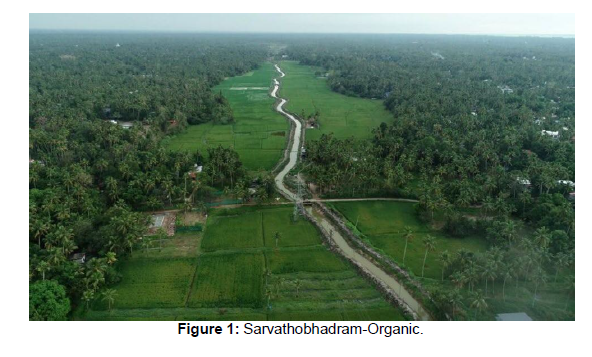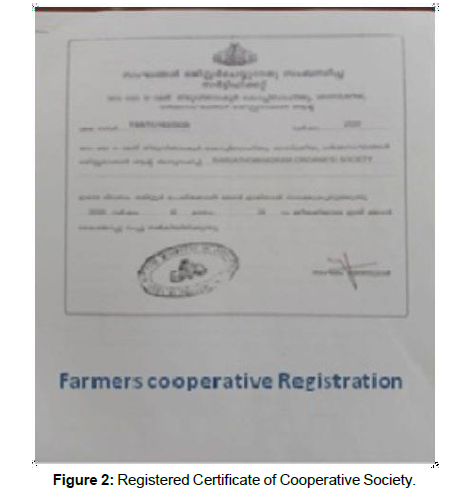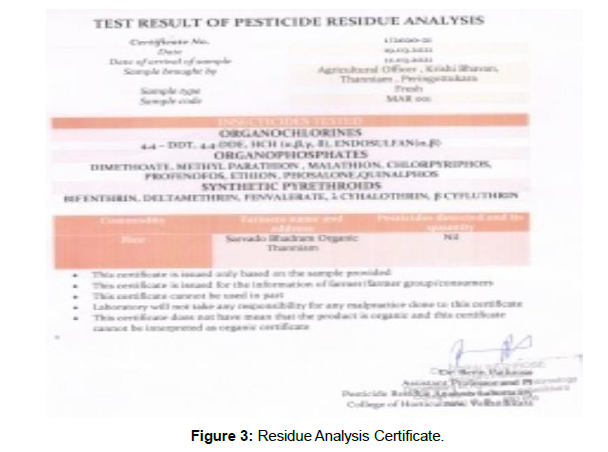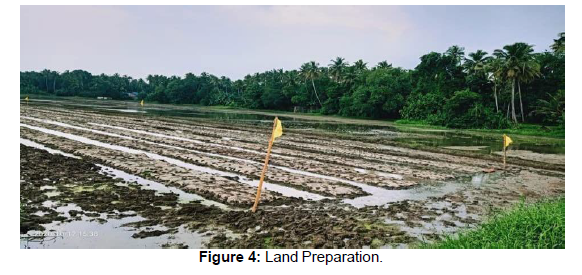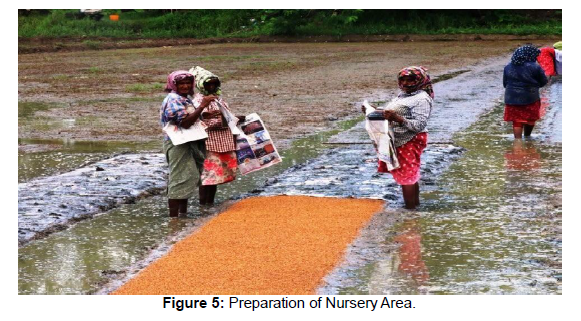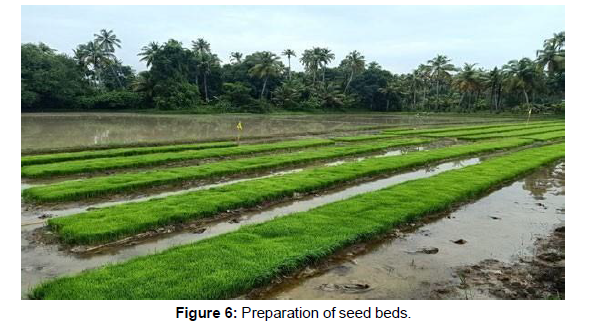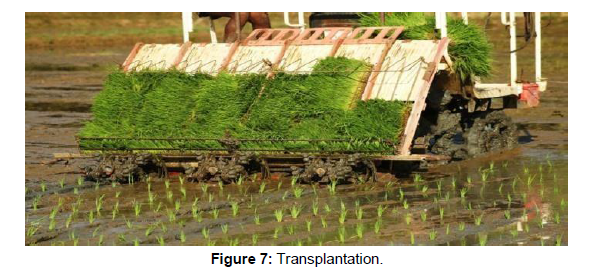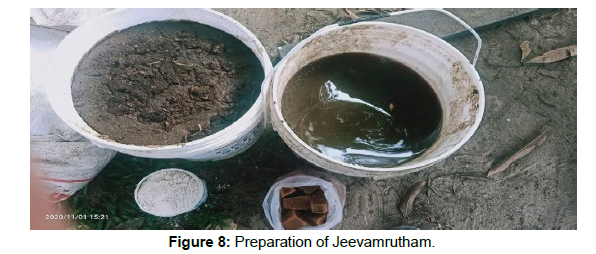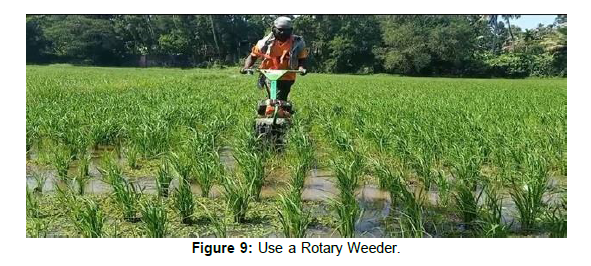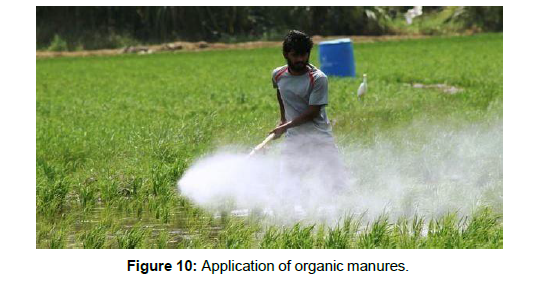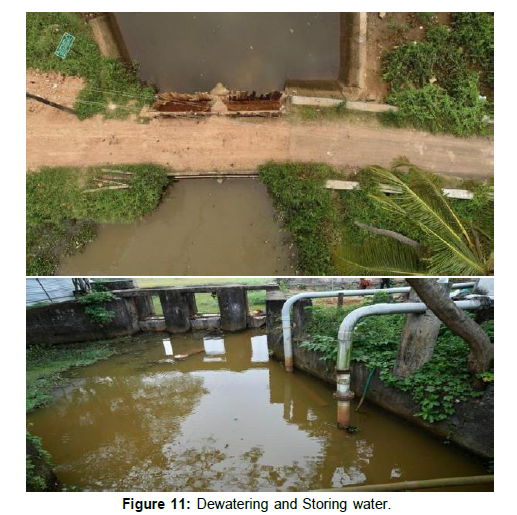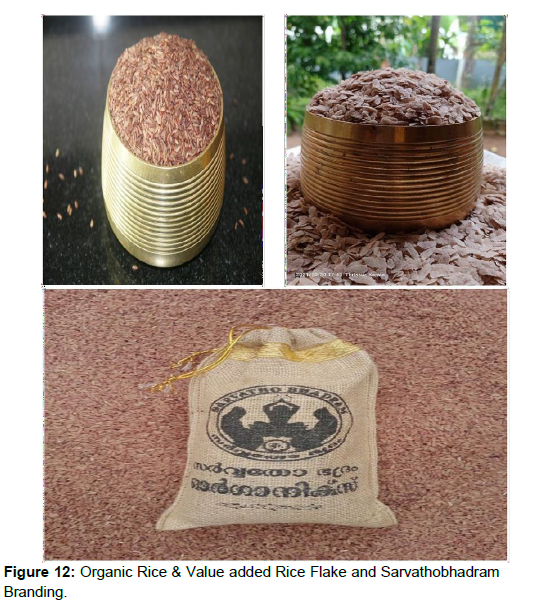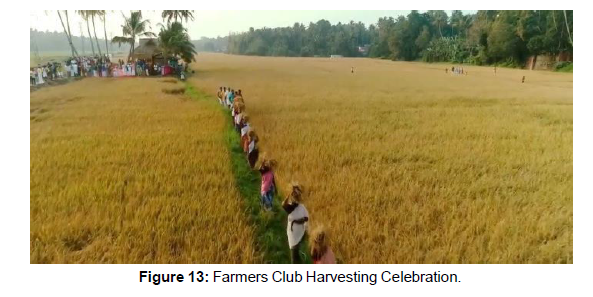Sarvathobhadram-Organic Initiative: Cooperative Model for Resilient Agriculture by Adopting System of Rice Intensification
Received: 28-Nov-2022 / Manuscript No. RROA-22-83255 / Editor assigned: 30-Nov-2022 / PreQC No. RROA-22-83255 / Reviewed: 14-Dec-2022 / QC No. RROA-22-83255 / Revised: 20-Dec-2022 / Manuscript No. RROA-22-83255 / Published Date: 27-Dec-2022 DOI: 10.4172/2375-4338.1000337 QI No. / RROA-22-83255
Abstract
Sarvathobhadram-Organic–Farmers Cooperative was helpful in supporting small and marginal farmers in customizing, adapting, and tailoring the system to their specific requirements. The Farmers Club, which has 50 members, was founded in May 2020 to create additional cash while also encouraging farmers to shift to organic farming using System of Rice Intensification (SRI). The club’s mission is to ensure food security, livelihood, and entrepreneurship in the Anthikad Block Panchayat. The project addressed climate change and resilience, collaborating with government departments and utilizing convergence to maximize the schemes accessible to farmers in panchayath. The transformation was sluggish
initially, but it accelerated over time, indicating that farmers have variable levels of satisfaction based on a variety of circumstances. Very young rice seedlings are planted singly in a grid pattern in the System of Rice Intensification (SRI), a management strategy for irrigated rice production. Throughout the whole growth season, the soil is kept moist but welldrained. Rice cultivation in the wetland starts with dewatering low-lying fields. In most places, permanent bunds have been constructed around fields. A network of barrages across the canal and at estuarine mouths has stopped saltwater to move inwards into their fields. A pumping operation system (in and outflow) has locally developed to pump out water
surplus and at the time of shortage, water pumped into the canal and then into the field from the river. If saltwater from the estuaries enters the field water pumped using modern pump-sets, to channels around through bunds. In order to minimize the risks and calamities brought on by climate change, the farmers’ organisations are aiming to fulfil SDG13 on climate action, which calls for enhanced resilience and the capacity to adapt local solutions. This paper examines the changing trend in the area after adopting organic farming using the SRI method, the increase in production, and the success of the convergence method. It also attempts to find out various constraints faced by farmers during the paradigm shift from conventional methods to organic and the results proven that SRI should be considered as a potential cultivation method for all farmer’s groups (Padasekharam).
Keywords: Sarvathobhadram-Organic; Kole wetland; Estuarine mouths; Thanniyam gram panchayat; organic Jyothi rice; Convergence method; Jeevamirtham; Natural methods; System of Rice Intensification
Keywords
Sarvathobhadram-Organic; Kole wetland; Estuarine mouths; Thanniyam gram panchayat; organic Jyothi rice; Convergence method; Jeevamirtham; Natural methods; System of Rice Intensification
Introduction
Thanniyam gram panchayath is located in Anthikad Block Panchayat, 20 kilometres from Thrissur, Kerala, India, and has an agrarian economy. Agriculture has sustained the men and women of panchayath for generations. Despite the fact that the panchayath receives plenty of rain, the lack of fresh water from the canals has left their crops parched. Saltwater has moved inwards onto their farms due to poor barrage management at the estuary mouths. The farmers have used fertilizers and pesticides for a long time, which resulted in a higher cost of cultivation. Most of the farmers left farming 17 years ago and hundreds of hectares became Culturable Waste-Land. Then in 2020, the village adopted organic farming under the initiative of Sarvathobhadram-Organic. Their operations began with assistance in developing kitchen gardens for self-sufficiency in horticultural goods, and eventually expanded to include 6500 families in a single block. They organised 50 farmers and scaled out the project, planting organic vegetables on twenty six acres of fallow land and farming paddy on sixty two acres of Wetlands. Wetlands perform a number of functions which can be summarised into hydrological, chemical, biological and socio-economic functions [1]. Water quality enhancement, sediment trapping, and wastewater treatment are some of the chemical processes. It serves as a sink or a natural cleaning facility for pollution, particularly when combined with nutrients. Farmers sell their paddy to Supplyco [The Kerala State Civil Supplies Corporation] at a rate of 28 per kilogram, which was set as an MSP [minimum support price] by the Kerala government, but is currently sold at Rs 70 per kilogram due to organic practice. With the initiative of farmer’s group government of Kerala under Rebuild Kerala constructed 3 sluices along 5 km length cannel and regulators along these canal networks can be used for controlling flow of water in fields, canals and rivers. The system of rice intensification (SRI) has recorded better values of physical water productivity (PWP) as well as the economic value of water (EVW) compared to other practices in the Kole wetland.
Discussion
Why Farmer’s Cooperative
Farmers’ cooperative societies have the advantage of collective action, which allows them to benefit from economies of scale by cutting their costs of obtaining inputs or renting services such as storage and transportation. They may also assist their members to become more resilient to economic and environmental shocks by involving them in decision-making processes that create more rural employment prospects or enable them to become more economically and socially empowered. Krishi officers play a critical role in technology transfer and the better use of convergence methods to get the program to the end users, the farmers. Location-specific need-based training stressing local challenges and issues is critical for bringing reasonable improvements to rural communities. Poor resource base and lack of finance, particularly for small and marginal farmers, offer a significant barrier to greater adoption.
Methodology
Fifty farmers were chosen randomly who used the SRI and conventional rice farming methods, respectively. The study is based on primary data that was gathered from rice farmers through personal interviews in 2020–21 utilizing a systematic, previously prepared interview schedule. Data were acquired on the location, the specifics of input utilisation, input cost, growing procedures, cultivation cost, yield, and output price. The study at Thanniyam Gram Panchayat and Sarvathobhadram-Organic included timely conversations with Krishi officer, other government departments that coordinated the convergence effort, Panchayath President, and ward members.
Challenges
• There is a labor shortage as a result of population growth and migration to other states and countries.
• Less young people, especially women, are involved in farming.
• Many people that grow rice have low incomes, and the cost of insecticides and fertiliser is skyrocketing.
• Growing economic disparity and inadequate dietary intake among rice users
• Need to improve resilience to climate change (droughts and floods)
• If saltwater from the estuaries enters the field water pumped using modern pump-sets, to channels around through bunds.
Case Study Description and Analysis
Paddy at Sixty Two Acres of wetland using System of Rice Intensification (SRI)
After learning about the paddy farmers’ plight, a strategy was devised to rebuild the community’s agricultural from the ground up. The initial stage was the foundation of the Sarvathobhadram-organic farmers’ group, which consists of 50 farmers, the majority of whom own land in the Peringottukara wetland area. The farmers intended to farm organically using SRI techniques.
Farmers come together and fight for a common cause
Together, farmers in the Kole wetlands work to stop reclamation and the degradation of the unique environment. This process of alternate dewatering and storage necessitates a great deal of forethought. The best method to accomplish this is to keep the wetlands under cultivation. Farmers in the area have created a rice-growing ecology that ensures food security. The Kole wetlands are also a seasonal home for a variety of migrating species. “Each contributes to the ecosystem’s protection and rejuvenation.”
Roles and Responsibilities
The group together owns approximately sixty two acres of fertile land with good rainfall and irrigation infrastructure which was not utilized from last 17 years. Internal management rules were developed by the members themselves, who specified their roles and responsibilities. They began with activities such as crop selection, soil testing, seed testing, crop planning, and water budgeting and conservation measures, with instruction from Sarvathobhadram- Organic and help from Krishi Bhavan (Agriculture office). The group addressed each stage in order to develop local solutions for farming [Figure 1].
Features of Peringottukara wetland cultivation
Peringottukara wetland cultivation differs from other types of farming in a number of ways. The wetlands are low-lying regions that are submerged for about six months of the year and are located 0.5 to 1 m below Mean Sea Level (MSL). Dewatering low-lying fields is the first step in rice production in the marsh. It is connected to the sea by small, large canals and ponds and is part of the natural drainage system. The wetland has all of the characteristics of a Kole wetland yet is not recognised as one.
Prepare crop calendar
The members themselves defined their responsibilities and formulated guidelines for internal management. With guidance from Sarvathobhadram-Organic and support from Krishi bhavan (Agriculture office), they prepare the crop calendar which helps to reduce cost and timelines. The group made a note of the selection of seed, planting date, plowing, weeding, fertilizing, and harvesting and budgeting.
System of rice intensification
According to Laulanie (1993) and Uphoff (2001), the system of rice intensification (SRI) is an integrated and agro-ecologically sound method of cultivating irrigated rice (Oryza sativa L. var. Indica), which opens new prospects for small farmers’ site-specific production systems. SRI is a designer innovation that effectively uses limited resources like land, labour, capital, and water, preserves soil and groundwater from chemical pollution, and is more affordable for small-scale farmers than input-dependent technologies that need capital and logistical assistance [2]. For a wide variety of rice genotypes, SRI techniques can result in enhanced phenotypic and agronomic performance [3].
Selection of seeds
The majority of farmers selected the Jyothi type since it sells for a decent price and has a ready market, and Krishibhavan provided the seeds. Jyothi stood out as the only long, bold, red-grained parboiling variety with a 120-day maturity time [Figure 2].
Land Preparation
To ensure that the rice field is ready for planting, it is necessary to prepare the land. In primary tillage ploughing to “till” and overturn the soil; harrowing to break up soil clods and assimilate plant debris; and levelling the field using tiller or tooth harrow. It is used to further loosen the previously ploughed land before sowing.
Secondary tillage is done with a tractor. The mud and water have been fully combined. Weeds, rice straw, and stubble have been ploughed into the soil and have rotted completely. The ground has been flattened.
Side protection (Varambu)
It’s used to store water and separate the fields. The Varambu assures the transport of water within the fields and removes the excess water (caused by rainfall and/or irrigation) from the fields [4].
Preparation of nursery area
Prepare 100 m2 nurseries to plant 1 ha. Select a levelled area near the water source. Spread a plastic sheet or used polythene gunny bags on the shallow raised bed to prevent roots growing deep into soil [Figure 3].
Preparation of seed beds
Used 35 kg of seeds to transplant in one acre of land and kept 1 m wide by convenient length. Raise the soil to a height of 5-10 cm. Pre-germinated seeds should be broadcast in well puddled and levelled soil. Construct drainage canals for proper water removal. Transplant seedlings when its 14-20 days old. To obtain quality planting materials, 35 kg of seeds are used, and farmers are testing SRI for the first time so quantity of seed used is higher. Manure from farm yards aids in the simple display of roots. Plants that are cultivated in manure that has been properly degraded have disease resistance. Later, the plant develops healthily and disease-free in the main field as well[Table 1].
| Layer | Thickness |
|---|---|
| 1st layer | 2 inch thick well decomposed FYM |
| 2nd layer | 2.5 ½ inch soil |
| 3rd layer | 2inch thick well decomposed FYM |
| 4th layer | 2 ½ inch soil |
| All these layers should be thoroughly mixed. | |
Table 1: Preparation of seed beds.
Transplantation
Rice seedlings were transplanted onto puddled soil with a transplanting machine after 8-10 days. 2–3 seedlings per hill, shallow depth, optimal spacing (14 cm). It aids in increased yields and reduced weeding. Rice is transplanted using rice transplanted equipment. Seedlings are grown on a thin layer of soil in trays that are 30 cm x 60 cm [5]. Transplanting is the process of using a machine to plant young rice seedlings into puddled soil, which saves time and effort. Each plant receives more room, air, and sunlight with broad spacing. Since the plant is robust and vigorous, there will be more tillers. The roots would absorb more nutrients and develop robustly and widely. There would be a longer panicle. The panicle contains more grains, and each grain weighs more as well [Table 2].
| Particulars | Amount (Rs) |
|---|---|
| Land Preparation (Primary and Secondary Tillage) | 4800 |
| Side protection | 1920 |
| Lime and Labour | 2600 |
| Seed beds and Transplantation | 7200 |
| Groundnut cake | 3000 |
| Neem Cake | 1800 |
| Cow dung | 1200 |
| Labour cost | 2880 |
| Jeevamruthum (4 times) | 8000 |
| Pseudomonas | 1000 |
| Fish waste and Labour | 1000 |
| Water use and management | 2000 |
| Weed management | 6000 |
| Harvesting | 2250 |
| Total | 45650 |
Table 2: Cost -per-Acre.
Preparation of Jeevamrutham
Because the high expense of agricultural chemicals and their reliance on them may frequently put marginal farmers in trouble, organic farming became obvious as a more viable option for the group.
Farmers were taught how to make natural insecticides and fertilisers like Jeevamirtham by Sarvathobhadram Organic (a mixture of cow dung and urine, legume powder, and jaggery) [6]. Jeevamrutham is an organic fertiliser that aids in the prevention of bacterial and fungal plant diseases [Figure 4].
Cono weeder Usage
Use a rotary weeder between crop rows in both directions beginning 10 days after planting to effectively manage weeds. Up until panicle initiation, around four rotational weeding spaced 10 to 15 days apart could be sufficient. Weeds are trodden on, and when they decompose, the nutrients are turned back into the soil. Frequently disturbing the soil produces positive physical, chemical, and biological effects on the soil. When using a weeder, the water level should be properly checked. It’s crucial to manually eliminate any remaining weeds. This results in a 60% reduction in weeding costs [Figure 5].
Fertiliser application
Using Cow Dung Solution (Beejamrutham):
Paddy seeds can benefit from an increase in germination by being soaked in a cow dung solution [7]. In this procedure, five gallons of water should be used to dilute 12 kg of fresh cow dung and two litters of cow urine. 10-15 kg of seeds should be soaked for 10–12 hours in water, followed by 5–6 hours in a cow dung solution [Figure 6].
Application of organic manures
Applying Farm Yard Manure (FYM) at a rate of 10 tonnes per acre will boost the availability of nutrients, supply plants with micronutrients, and improve the physical characteristics of the soil, such as its structure and water-holding capacity. On an average it contains 0.5%N, 0.2% P2O5 and 0.5% K2O. Application of 10 tons FYM to the soil gives 50Kg N, 20Kg P2O5 and 50 Kg K2O. The balance of soil microorganisms can be changed to some extent to suppress nematodes and fungus that parasitize plants. On the 15th day after cono- weeding, apply 50kg of Jeevamrutham /acre at regular interval of 25 days. Life species abounding in the soil consume organic matter as sustenance. The number of soil microorganisms increases dramatically with the addition of organic materials [8]. When nutrients are needed, the microorganisms convert them into forms that are readily available to the human body [Figure 7].
Case Study Findings and Observations
Cost -per-Acre
Convergence and group farming
Canal Cleaning: The job of cleaning and desilting a 1 km canal was done as part of the Rebuild Kerala initiative, which aims to reconstruct and establish ecological and technical safeguards so that the restructured assets may better survive future floods” [Figure 8].
Seed Selection: Farmers planted about 35 kilograms/acre of organic Joythi rice (Seeds) on their field in June 2020. (Sown Seeds is 1750 Kgs for 25 Hectares). The farmers received the seed as part of the Subhiksha Keralam scheme, which was sponsored by the Kerala government through convergence. The fields performed a ceremony of worship in accordance with their customs in order to receive blessings from Lord Sree Vishnumaya, their patron god [9].
Finance Assistance: Subhiksha Keralam and People Plan Fund provide financial help of Rs 5,000 per acre (janakeeyasoothranam). For the promotion of fallow land cultivation and group based paddy promotion concentrated in the major rice growing tracts of the State under seven Special Agriculture Zones with natural endowments for augmenting rice productivity, Rs 2250 per acre was given under the sustainable rice development scheme [Figure 9].
Dewatering and Storing water
Dewatered waters from the padavu were kept in canals/drainage networks between these padavu and utilised subsequently for irrigation. Temporary bunds were built around each plot (padavu) in this Kayal(canal) area and used for cultivation from December to May. The government under the project Rebuild Kerala built three sluices along a 5 km long canal at the request of a Farmers’ Group. The regulators along this network of canals can be used to control the flow of fields, canals, and rivers. This procedure makes sure that the water is recycled for use in agricultural. 100 acres are first dewatered, and farming is carried out. The canal is used to hold the water that is pumped out. We return this water to the fields after around 15 days so that it can be reused. Throughout the cycle, the water is continuously recycled rather than being drained into the ocean. Pumping is done with lifting equipment like a motor and pump. Field dewatering is accomplished by axial flow pumps. 1 kg of rice requires 2800 litres of water from land preparation to harvesting. Therefore, on average, 44,80,000 litres (average 1600kg/Acre *2800lt), or 1183491 gallons, of water were needed for one acre. Therefore, by pumping water inside, dewatering it, and storing it in a cannel, and reusing it an farmers can save 2200 000 litres or 581 179 gallons of water per acres [Figure 10].
Other Assistance: Aside from financial support, Agriculture department provided a 75% rebate on lime costs, and all paddy crops were protected under the state crop insurance system [Figure 11].
Farm-to-Direct Market Approach
Good marketing is the key to selling their products. However, the small and marginal farmers battled with agricultural marketing and market access. Sarvathobhadram-Organic assisted by locating direct bulk customers at major markets, removing the need for middlemen
[10] [Figure 12].
Farmers established a rural market with the support of the panchayath, where they sell not just rice but also by-products such as broken rice, rice with 30% and 70% bran, and rice flakes. As a result, the farmers were able to pay off all of their cooperative and nationalised bank loans with just one successful season’s earnings. After obtaining FSSAI license they started branding and packaging the products which help build a concise brand, attract many new customers and developed regular customers for their rice [Figure 13].
Result and Discussion
It was apparent after the first harvest in January 2021 that all of their hard work had paid off. The farmers’ initial expenditures were drastically reduced by switching completely to organic practises and taking advantage of government programs such as Rebuild Kerala, Kerala Government Initiative, and Subhiksha. After seventeen years, the Sarvathobhadram-Organic farmers reaped their first profitable crop thanks to the convergence technique. Farmers were able to get 1500kg/acre operating organically, which resulted in a massive rise in net income. They earned Rs 1,05000 by selling the rice at a price of 70 rupees per kilogram. After lowering their cultivation costs by Rs 45650, they made a profit of Rs 59350, or nearly 50%. Those who used synthetic fertilisers (chemical fertilisers) to grow paddy got a yield of 2000kg/acre and sold at the Kerala government’s minimum support price of 28 Rs. The farmers received a total price of Rs 56000, and after deducting the farming cost of Rs 47000 the profit is Rs 9000, or 16% profit. The use of postharvest procedures like cutting, cleaning, sorting, and branding contributed to profitability as well. This not only increased the value of their rice on the market. It also enabled them to sell their organic rice paddy, which is in high demand all the time. By using the SRI method, the farmers group was able to raise maximum net returns above conventional paddy by 40% while lowering cultivation costs and labour costs.
Conclusion and Recommendation
Organic farming was a success in Thanniyam panchayath. Farms’ confidence in the local agriculture department has improved as well, and most farmers now benefit from government initiatives that use convergence. During covid, farmers regained their confidence, established hundreds of direct and indirect jobs, and regained their self-respect. After 17 years when farming restarted at Kole Wetland, a lot of preparation went into this system of alternate dewatering
and storing. . Reusing stored water boosts the productivity of the water that has been abstracted, usually in agriculture, allowing for the growth of “more crops per drop” while maintaining environmental preservation and conservation. Water is at the centre of the Circular Economy. Brown rice flakes and Puttu Podi are value-added products having high demand. Organic farming contributes to the preservation and improvement of fertility, soil structure, and biodiversity, as well as being fine-tuned to meet local production conditions and market demands. They plan to build a warehouse and begin the process of obtaining organic certification next year, as well as a self-sufficient hamlet that provides healthy food to all. The satisfaction was reported using System of Rice Intensification (SRI) with regard to increasing cropping intensity, increase the number of soil beneficial microbes, reducing cost of cultivation, ease in marketing of farm produce, selection of quality seeds, as well as insect biodiversity and preparation of Organic manures and pesticides.
Acknowledgement
None
Conflict of Interest
None
References
- Barbier EB (1994) Valuing Environmental Functions: Tropical Wetlands. Land Economics US 70:155-73.
- https://fas.org.in/rice-cultivation-in-kole-wetlands-of-kerala/
- Thatchinamoorthy C, Rexlin S (2014) A Study on Profile System of Rice Intensification (SRI) Paddy Growers in Tirunelveli District of Tamil Nadu. Int J Curr Res IND 6:6064-66.
- Thatchinamoorthy C (2016) System of Rice Intensification in Empowering Self-Help Group People. Innov J Agr Sci IND 4:1-3.
- https://global.oup.com/academic/product/ecology-and-economics-oip-9780195662139?lang=en&cc=in
- Thatchinamoorthy C (2017) A Study On System Of Rice Intensification (Sri): A Diagnostic Study In Tirunelveli District Of Tamil Nadu. Int J Curr Agri Sci IND 7:250-253.
- Arsil P (2022) Perceived attributes driving the adoption of system of rice intensification: The Indonesian farmers’ view. Open Agriculture EU 7:1-9.
- Sreeni K R (2017) Group Farming–means to end Poverty and Hunger in Villages, J Agri Ext Manag IND 7:217-225.
- Meesala K., Rasala S (2022) Potential of System of Rice Intensification (SRI) to contribute to the policy objectives: Paradigm of three-tier approach in southern Telangana - A case study of Narayanpet. Agri Sci IND 13:1-13.
- Mehmet AU, Cahit G (2022) Growing more rice with less water: the System of Rice Intensification and water productivity in Vietnam. Aus J Agri Res UK 66:581-611.
Indexed at, Google Scholar, Crossref
Indexed at, Google Scholar, Crossref
Citation: Sreeni KR (2022) Sarvathobhadram-Organic Initiative: Cooperative Model for Resilient Agriculture by Adopting System of Rice Intensification. J Rice Res 10: 337. DOI: 10.4172/2375-4338.1000337
Copyright: © 2022 Sreeni KR. This is an open-access article distributed under the terms of the Creative Commons Attribution License, which permits unrestricted use, distribution, and reproduction in any medium, provided the original author and source are credited.
Select your language of interest to view the total content in your interested language
Share This Article
Recommended Journals
Open Access Journals
Article Tools
Article Usage
- Total views: 5469
- [From(publication date): 0-2022 - Dec 19, 2025]
- Breakdown by view type
- HTML page views: 4919
- PDF downloads: 550

